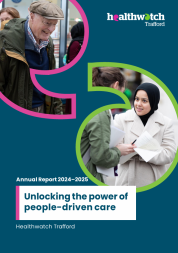Implementation of the Accessible Information Standard

The Accessible Information Standard (AIS) has been embedded in NHS England's Equality Frameworks and Information Standards since 2016 and provides an imperative for NHS providers to ensure “people who have a disability, impairment or sensory loss get information that they can access and understand, and any communication support that they need from health and care services” (NHS England, 2017).
This project aimed to review AIS procedures put in place by organisations to which the standard applies, identify any instances where AIS obligations are not currently being met and understand why, and identify how any gaps in AIS provision affect service users.
Our research yielded positive results: 79% of patients reported never being denied information in the format needed, and 93% of respondents who needed additional help said they were happy with the support provided when communicating with services. However, 20% of the healthcare providers we spoke to remained unaware of the AIS and there was a consistent lack of accessible communication (such as braille, or a hearing loop) across pharmacies, opticians, GPs, and dentists.
Our case study of Trafford General Hospital showed a strong established framework for AIS compliance, but with variation in how these standards are applied and experienced in different areas.
There is room for improvement, without which some patients remain unable to access care or properly understand the treatment they are receiving. Our report makes several recommendations that we believe would improve the quality of care, benefit patients, and benefit the relationship between patients and providers. Overall, though, there are strides being made in accessible information across Trafford care providers, and the picture is an encouraging one.
Our recommendations in full
- Improve awareness of AIS to improve compliance
Although we found a considerable proportion of healthcare providers are familiar with the AIS, awareness could be improved. Similarly, most patients who required support, found it either a little (40%) or very (53%) helpful. However, improved awareness would help improve inclusion and compliance with the standards and subsequently, enhance patient access to services.
- The accessibility and language needs of a service’s patient population should be considered when displaying information, and services should work towards improving readability.
We found that all but one of the healthcare providers we visited had information about the AIS or posters related to it. However, other informational materials such as posters about staff roles or complaints information were not always easily readable, including issues like small text size, and limited language availability. Services could aim to improve these by using guides such as Web Content Accessibility Guidelines1. These changes may include larger text, higher contrast, and different languages (where appropriate, for example if a service has a high population of speakers of other languages).
- Ensure hearing loops are available and functional, with signs indicating their availability.
During our visits, we found that most practices did not have signage for hearing loops, regardless of whether or not they were available. Clear signage is important to avoid patients accessing services and feeling discouraged from or unable to seek help. Research by Healthwatch Southampton2 and the Royal National Institute for the Deaf3 show that across the UK, hearing loop availability and functionality remains areas of concern.
- Conduct further research to understand communication challenges patients may face when they do not fully comprehend information.
A small number of patients indicated that they sometimes struggle to understand health information provided. Understanding the challenges these patients face can inform strategies to improve communication. Additional investigation could provide valuable insights barriers, enabling organisations to adapt their approaches and enhance the effectiveness of the AIS.

